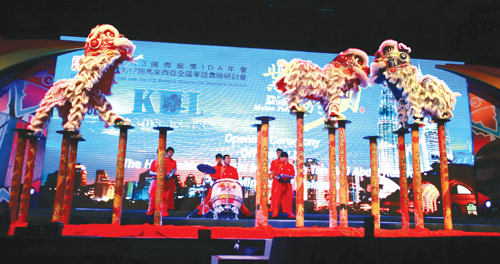
Kuala Lumpur Convention Centre overcomes myriad challenges to successfully host China’s largest insurance and financial meeting. By S Puvaneswary
It was during the ICCA Asia Pacific Business Leads Exchange Workshop in March 2011 when the wheels were set in motion to bid for the 2013 edition of the International Dragon Award (IDA) Annual Conference – an event said to be the largest annual meeting of China’s insurance and financial services industry.
Kuala Lumpur Convention Centre and the Malaysia Convention & Exhibition Bureau (MyCEB) submitted a full bid proposal a week later and conducted an official site visit in mid-June.
In order to understand the requirements of the event, representatives from the Centre and MyCEB attended IDA 2011.
Recalling the early stages of the bid, Richard Wu, 2013 IDA Annual Meeting chairman, said: “Zulkefli Sharif, the CEO of MyCEB, (said) we would get government support if we held the event in Malaysia. He promised assistance in inviting government officials.”
Indeed, MyCEB helped arrange for local VIPs to attend the opening ceremony, namely Malaysia prime minister, Najib Abdul Razak; minister of tourism and culture, Mohamed Nazri Abdul Aziz; and Kuala Lumpur mayor, Ahmad Phesal Talib. It also helped in the coordination of the official opening by Najib, presentation of awards to speakers by Mohamed Nazri and a welcome dinner for top CEOs, hosted by Ahmad Phesal.
The Centre’s general manager, Alan Pryor, revealed that the technical requirements for the event were complex and the client had insisted on having all participants altogether in one venue. “This meant multiple revisions to the floor plan to ensure everyone (in the audience) could view the proceedings. For example, to house the opening ceremony, Exhibition Halls 1 and 2 were combined into one massive space with three stages coming together in the centre to form a T-shape,” he explained.
Besides an 11.6m main screen on the main stage, 10 additional hanging screens measuring six to eight metres in width were strategically placed across the 167m-wide hall to ensure clear sight lines for all delegates. Wide rectangular seating blocks were configured at different angles so information projected on the various screens remained visible to all.
Another challenge was to create menus that satisfied the palates of delegates from more than 16 countries.
Pryor said: “The culinary team researched the delegates’ profile to determine where they were from and what they would probably like to eat.”
Based on the results, the team came up with a catering solution that enabled delegates to choose from a variety of food kiosks. Pop-up public catering outlets were also conveniently located in Exhibition Hall 4 to offer more food choices and snacks on the go.
The culinary team also came up with popular breakfast and lunch items and updated the menu daily.
Meticulous attention went into F&B planning to avoid food waste, and consumption patterns were monitored daily to manage food quantities and choices.
To cater to the massive audience, the 2,245m2 Exhibition Hall 4 was also converted for the first time into a catering facility to provide delegates with easy access to F&B. The space featured a unique set-up of food kiosks and a dining area that resembled a local street food bazaar. A free Wi-Fi Zone was also carved out in Exhibition Hall 4.
As Mandarin was the primary language of the client and a large number of delegates, the Centre chose to have all correspondence and documentation with the client in Mandarin, equip the laision team with a staff fluent in the language, provide more Mandarin-speaking ambassadors and catering staff, and have all materials such as signage and menus in both English and Mandarin.






















